Series
Between 1907 and 1916, several companies tried to capitalize on the popularity of the Scouting movement by branding their products with the name "Scout" and using graphic images of Boy Scouts to promote their merchandise. In 1916, the Boy Scouts of America received a congressional charter that granted the organization exclusive rights to the term “Boy Scout,” the uniforms, and the insignia. The BSA protected this right by very aggressively pursuing all infringements. As a result, any privately printed series of cards that were issued after 1916 were relatively short-lived. In spite of this, there are several very attractive series of postcards published both before and after that date.
(01) Scout Gum Company of Rochester, NY: 1914. (12 cards)
The Scout Gum Company copyrighted and published a series of twelve numbered postcards depicting Scouts engaged in various activities. The drawings for the attractive multicolored chromo-lithograph cards were all executed by H. C. Edwards whose signature is visible in most of the pictures.
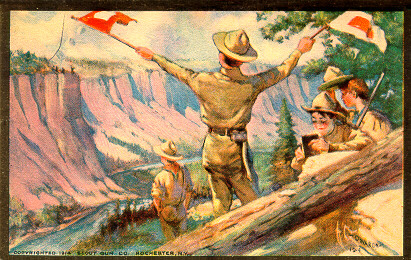
The backs of the cards, in brown, each contain a number, a title, a brief paragraph describing the activity, and a trademark notice for "Scout".

Like many advertising giveaways, the postcards were printed on cheap card stock that deteriorates easily. It is very difficult to find examples in excellent condition without chipped edges or corners.
The Boy Scouts of America did not authorize these cards, and they were not available for long after 1916.
(02) Inter Art Company: c. 1914 (6 cards)
These cards were printed and sold in England but a separate edition was available in the United States. All cards have an inscription on the back indicating the “Scout Series,” the card number (from #444 to #449,) and "Printed in England." The cards manufactured for sale England have a second line with "Inter-Art Co., Southampton House, London, W.C."
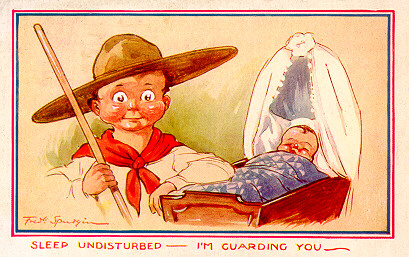
This early war time series has a patriotic theme and includes a distinctive red, white, and blue striped border. Each card is signed by Fred Spurgin, a well known and popular British post card illustrator.
(03) Commercial Colortype Company of Chicago, IL: (37 cards)
Commissioned by the Redpath-Brockway Chautauqua to be sold at their circuit chautauquas, this series of twelve unnumbered cards was published by Curt-Teich, a prolific Chicago based postcard publisher who had them printed by the Commercial Colortype Company, another Chicago company. Each of the cards has the latter company's mark in the lower left of the front of the card.
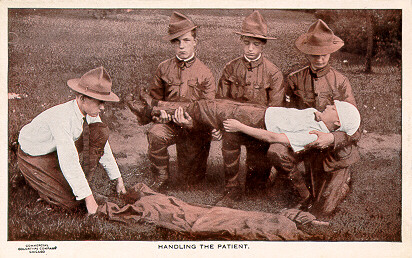
There were three identifiable printings for the cards:
- Type I - The backs of the cards were printed in reddish-brown, or henna, ink (shown). Each carries an inscription that reads "Be Prepared! This is the Motto of the Boy Scouts of America." That is followed by a paragraph giving a description that is sometimes only loosely related to the activity depicted on the front of the cards. (12 cards)
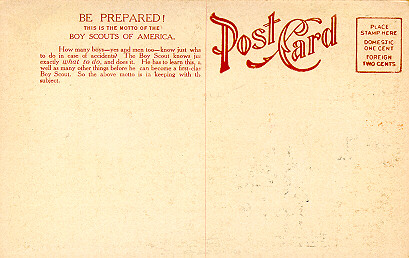
Type II - The backs of the cards are identical in content and in format to the cards of Type I. However, they were printed in black ink. (12 cards)
- Type III - The backs of the cards are printed in henna, but they have no inscription at all. (12 cards)
Some collectors believe that the order given here coincides with the order of the printings: that the company dropped the inscription when the B.S.A., armed with their Congressional Charter of June, 1916 asked them to refrain from using their name. Eventually they stopped producing the cards completely. All of the cards are relatively rare today and to acquire a complete set requires a great deal of persistence.
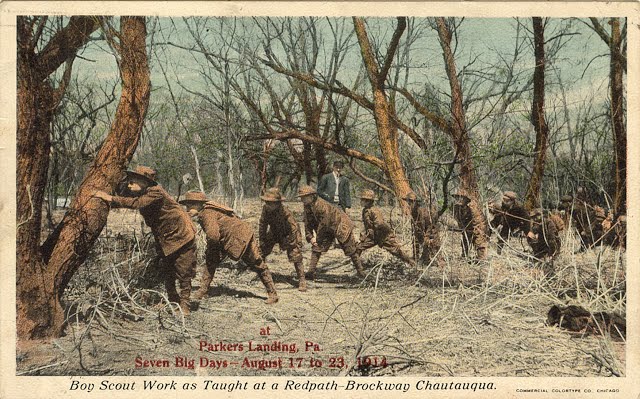
One additional card titled "Boy Scout Work as Taught at a Redpath-Brockway Chautauqua" was used as an advertising piece to attract attendees to the week long events. The Chautauquas hired self-styled "Scoutmasters" who kept the local youths occupied while their parents watched the performances, listened to the concerts, and enjoyed the lectures. The images of the Chautauqua Scoutmasters that appear on postcards are more reminiscent of A.B.S. leaders' uniforms than that the B.S.A. The Chautauquas recruited local leaders, ministers, teachers, and private citizens, and provided them with the paperwork necessary to register with the B.S.A. in New York. The "Scoutmasters" helped organize Troops, and (of course) arranged to sell them uniforms, equipment, and even postcards. One estimate states that between 1911 and 1916, the circuit Chatauquas left in their wakes more that 3000 newly formed B.S.A. Troops. Although it benefited from the increase in enrollment, so far no evidence has come to light that the B.S.A. had anything to do with, or was even aware of these activities that were being carried out in its name. On rare occasions a postcard (like the one above) comes to light that was overprinted to advertise a specific week in a specific place.
(04) Gartner and Bender: c. 1915 (6 cards)
These beautiful cards are unsigned and the artist remains unknown although the Gartner and Bender signature on the back makes them easy to identify. The origin of this elusive unnumbered series of cards remains unclear. It was most probably introduced sometime between 1912 and 1918. The cards were certainly not issued by the B.S.A., and most likely they were authorized neither by that organization nor by one of its competitors. The cards show boys in unmistakable uniforms, but no insignia or other identifying marks are visible, and the word "Scout", which appears in each of the descriptions, appears to be carefully used in a generic sense. The themes for the cards seem to come from a mixture of the Scout Law, the Scout Slogan and requirements for various badges. In some cases the text does not seem to fit the picture at all.
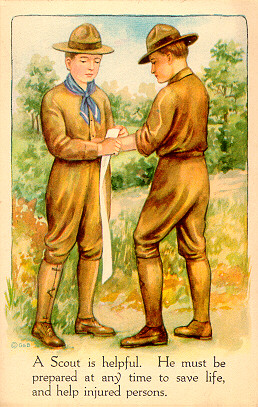
(05) Series #265 - Boy Scout & Campfire Girl: c. 1917 (20 cards)
The Fairman Company of Cincinnati and New York produced a series of ten cards under their trademark "The Pink of Perfection." The cards were later reprinted by the Gibson Art Co. The publisher tried to circumvent the Congressional Charter by using the word “Scout” by itself. (only on one card does “boy Scout” appear with a lower case “b.”) The company eventually withdrew the cards.
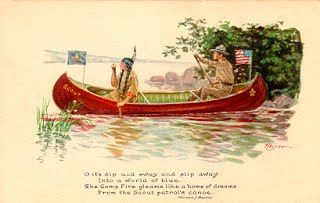
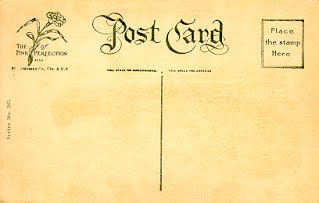
Each card bears a brief poem by Florence J. Martin and a drawing signed "Relyea," (Charles M. Relyea was a prominent illustrator of the period.) All of the scenes show a Campfire girl dressed as an Indian maiden and/or a Boy Scout in uniform. The back of each of the cards gives the series number -- #265.
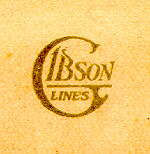
These cards are difficult to find. Many dealers file some under “Indians” and others under “Military.” In addition, the “Relyea” signature is often difficult to read for those not specifically looking for it.
(06) Scoutoons, Lawrence Co., NY: 1930s (total number of cards unknown.)
The 1930s saw a need for inexpensive postcards for summer camps. This was brought about by the combination of the "great depression", a serious decline in the postcard industry, and the rapid growth of summer camping. Reacting to this market, the Lawrence company of New York began publishing several series of cheap quality camp postcards. The first ("A" series) seems to have been originally targeted specifically at Boy Scout Camps.
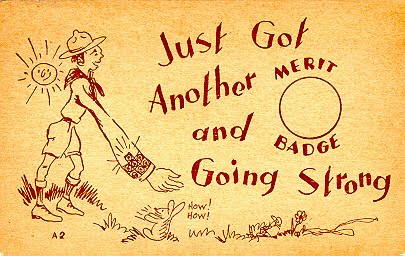
It was produced under the trademark "Scoutoons," and the cards featured boys wearing stylized uniforms and referred to Scouting terms. The later series repeated the same themes, but without uniforms or any Scouting-specific references, the cards took on a generic appearance and, presumably, appealed to a wider audience. The Lawrence Company also began using a generic designation, "Camptoons," and seem to have experimented with cards called "Post Cartoons" as well. They also produced similar series showing girls and Girl Scouts.
Cards from several of the series can be found both as "Scoutoons" and as "Camptoons." The cards were available from the early 1930s at least until the early 1940s. They appear to be the direct forerunner of the generic Boy Scout Camp postcards of 1947. The same sentiments and themes can be recognized in each.
Note: Two series of postcards published by the Merin Studios of Philadelphia, PA for the National Jamborees in 1950 and 1957, although not issued by the BSA, appear to have been issued under license of the BSA. Because they are usually assumed to be official cards, they are listed with Official Cards under Jamborees.